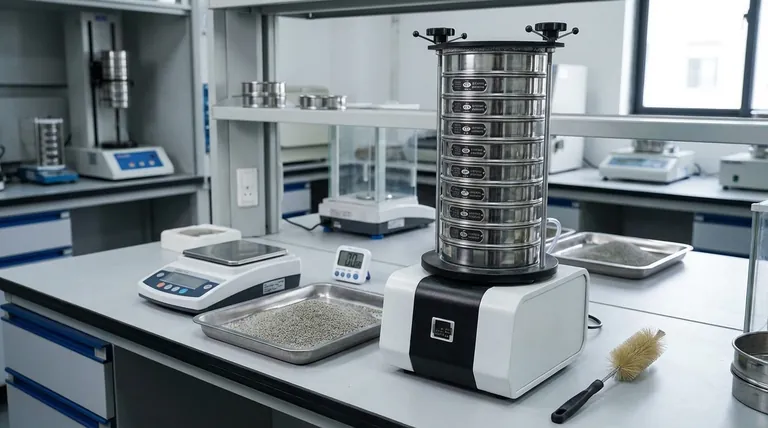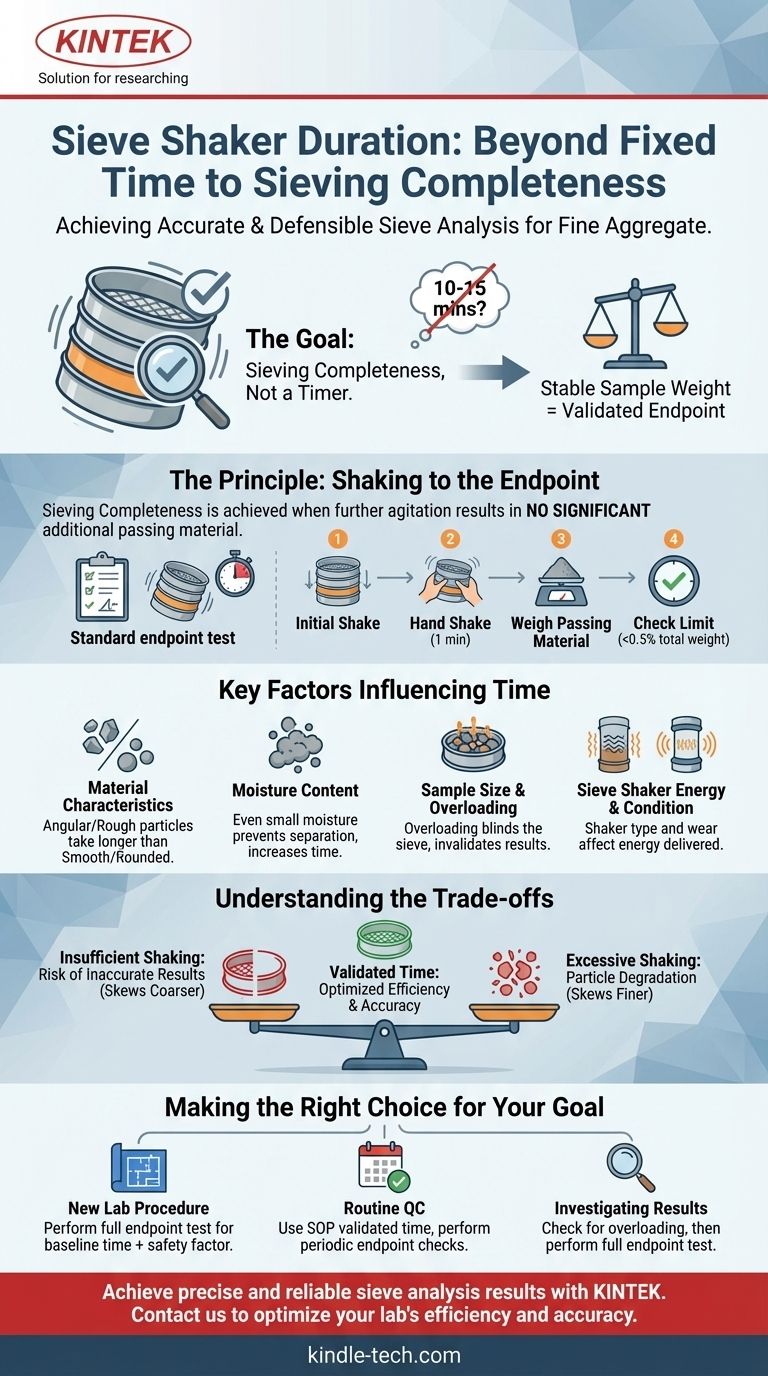While a common starting point is 10 to 15 minutes, the correct duration for running a sieve shaker is not a fixed time but the time required to achieve a verified endpoint. This duration is unique to your specific material, sample size, and equipment. Relying on a generic time without validation risks producing inaccurate and indefensible test results.
The goal of sieve analysis is not to shake for a set number of minutes, but to achieve sieving completeness. The correct duration is the minimum time required for the sample weight on each sieve to become stable, a point that must be confirmed with a standardized endpoint test.

The Principle: Shaking to the Endpoint
The core of a reliable sieve analysis, as outlined in standards like ASTM C136, is the concept of "sieving to an endpoint." This ensures that practically all particles that can pass through a sieve mesh have had the opportunity to do so.
What is Sieving Completeness?
Sieving completeness is the state where further agitation of the material does not cause a significant amount of additional material to pass through any of the sieves in the stack.
The process is finished not when a timer goes off, but when the separation is effectively complete. This principle ensures results are repeatable, regardless of minor variations in equipment or operator.
The Standard Endpoint Test
To determine if you have reached completeness, you must perform an endpoint test. The standard method is straightforward:
- After an initial shaking period (e.g., 10 minutes), stop the shaker.
- Individually take each sieve, cover it, and shake it by hand for one minute.
- Weigh the material that passes through the sieve during that minute.
- If this weight is less than a specified limit (typically 0.5% of the total sample weight for fine aggregate sieves), the test for that sieve is considered complete.
If the weight passed exceeds the limit, the mechanical shaking was insufficient. You must return the material to the stack and continue shaking for a longer interval, then repeat the verification.
Why a Fixed Time Often Fails
Relying on a fixed time, like "15 minutes," is a common but flawed shortcut. It assumes that today's material, sample size, and shaker performance are identical to when that time was first established.
This assumption is rarely true. Factors like particle shape, moisture, and sieve condition constantly change, making periodic endpoint verification essential for accuracy.
Key Factors Influencing Sieving Time
The ideal sieving time is not a universal constant. It is a variable dependent on several critical factors in your specific lab environment.
Material Characteristics
Angular, rough particles (like crushed sand) will take significantly longer to sieve than smooth, rounded particles (like natural river sand).
Likewise, even a small amount of residual moisture can cause fine particles to clump together and stick to the sieve mesh, dramatically increasing the required time or making a complete separation impossible.
Sample Size and Sieve Overloading
Overloading a sieve is the most common error in sieve analysis. When too much material is placed on a sieve, it creates a bed of particles so deep that those at the bottom never get a chance to meet the mesh.
This "blinds" the sieve, preventing proper separation no matter how long you run the shaker. Always adhere to the maximum allowable weights for each sieve size as specified by your governing standard.
Sieve Shaker Energy
Different types of shakers (e.g., mechanical tapping vs. orbital vs. vibratory) impart different energy levels and patterns into the sieve stack.
Furthermore, the performance of a shaker can degrade over time due to wear on its mechanical components. A new, vigorous shaker may achieve endpoint in 8 minutes, while an older model might require 15 minutes for the same material.
Understanding the Trade-offs
Optimizing sieving time is a balance between laboratory efficiency and analytical accuracy. Understanding the consequences of getting it wrong is critical.
Insufficient Shaking: The Risk of Inaccurate Results
This is the most significant risk. If shaking is stopped too early, an excessive amount of fine material will be retained on coarser sieves.
This skews the gradation curve, making the sample appear coarser than it actually is. This can lead to incorrect mix designs, rejection of good material, or acceptance of bad material.
Excessive Shaking: Particle Degradation
For softer or more friable aggregates, shaking for too long can be just as problematic. The constant agitation and particle-on-particle impact can break down weaker particles.
This process creates artificial fines that were not present in the original sample, skewing the gradation to appear finer than it truly is.
The Balance of Efficiency and Accuracy
The goal is to establish the shortest duration that consistently achieves sieving completeness. This validated time becomes a reliable part of your Standard Operating Procedure (SOP), maximizing lab throughput without sacrificing the integrity of your results.
Making the Right Choice for Your Goal
To ensure your results are accurate and defensible, you must establish a specific, validated shaking time for each type of material you test.
- If your primary focus is establishing a new lab procedure: Perform the full endpoint test on a representative sample to determine the baseline time required to achieve completeness, then add a small safety factor (e.g., 1-2 minutes).
- If your primary focus is routine quality control: Use the established, validated time from your SOP but perform an endpoint verification check periodically (e.g., weekly or monthly) or whenever you encounter a new material source.
- If your primary focus is investigating an unexpected result: Do not simply re-run the test. First, check for sieve overloading, and then perform a full endpoint test on the sample to confirm the original shaking time was adequate.
Following this methodical approach ensures your sieve analysis results are not just fast, but fundamentally correct and defensible.
Summary Table:
| Factor | Impact on Sieving Time |
|---|---|
| Material Type | Angular particles take longer than smooth, rounded ones. |
| Moisture Content | Even small amounts of moisture can significantly increase time. |
| Sample Size | Overloading a sieve prevents proper separation, invalidating results. |
| Shaker Type & Condition | Shaker energy and wear affect the time to reach the endpoint. |
Achieve precise and reliable sieve analysis results with KINTEK.
Accurate gradation data is critical for quality control and material specification. Our range of high-performance sieve shakers and lab consumables is designed to deliver the consistent, vigorous agitation needed to reach sieving completeness efficiently, preventing the risks of under-shaking or particle degradation.
Let our experts help you select the right equipment to validate your procedures and ensure defensible results. Contact KINTEK today to optimize your lab's efficiency and accuracy.
Visual Guide

Related Products
- Laboratory Test Sieves and Vibratory Sieve Shaker Machine
- Laboratory Vibratory Sieve Shaker Machine for Dry and Wet Three-Dimensional Sieving
- Laboratory Vortex Mixer Orbital Shaker Multifunctional Rotation Oscillation Mixer
- Vibratory Sieve Shaker Machine Dry Three-Dimensional Vibrating Sieve
- Laboratory Vibratory Sieve Shaker Machine Slap Vibrating Sieve
People Also Ask
- What size are test sieves? A Guide to Frame Diameters and Mesh Sizes
- What is the maximum sieving deviation permitted? A Guide to ASTM & ISO Precision Limits
- What are the disadvantages of sieve machine? Key Limitations in Particle Size Analysis
- What are the different methods of sieving? Choose the Right Technique for Your Material
- Which Cannot be separated by sieving? Understanding the Limits of Particle Size Separation



















